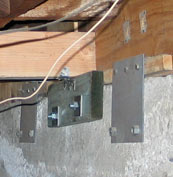Preventing Soft Story Collapse
Half of all the homes that became uninhabitable following California’s 1989 Loma Prieta Earthquake were the result of soft story failure. Many of the apartment complexes severely damaged during the Northridge earthquake in 1994 were also caused by soft story structural issues. This includes the collapse of the Northridge Meadows apartments, which resulted in the death of 16 residents.
In the San Francisco area, it is believed that the next moderate to large earthquake could lead to more than 150,000 soft story collapses. In Los Angeles, experts say a big earthquake could cause the collapse of 1,500 concrete buildings throughout the city.

Soft story buildings have one or more floors with large openings that would normally require a shear wall for stabilization. Types of soft story buildings include apartments built over a parking garage or retail businesses with large windows, as well as multi-level commercial structures with floors that have large spaces, windows and doors. Soft story buildings most likely to collapse are those built on street corners or unstable soil. However, any multi-level residential or commercial building with unreinforced ground floor openings is a potential hazard during a quake, especially buildings constructed between the 1960s and 1980s.
Technically, a building is considered “soft story” if a floor is less than 70% as strong as the floor above it, or less than 80% as strong as the average strength (stiffness) of the three floors on top of it. This is because the weaker floor is more susceptible to lateral motion from the quake. The side-to-side earthquake motion can create enough stress to damage or collapse the floor. A single floor collapse can lead to the collapse of the entire building.
With an estimated 20,000 soft story buildings throughout Los Angeles, earthquake retrofitting is a serious matter. A new proposal could result in mandatory retrofitting requirements with a 30-year retrofit deadline. To date, only a relatively small number of property owners have taken action to improve the structural integrity of their buildings.
The retrofitting process begins with an inspection by a qualified building contractor who has experience in soft story earthquake retrofitting. Several factors are taken into consideration when developing the retrofitting plan. Types of retrofitting include strengthening existing walls with braces or plywood, anchoring walls to the foundation and adding shear walls. The goal of the retrofitting is to make the building earthquake ready and safe by increasing the structure’s lateral stiffness and strength.
What happens if retrofitting is neglected? In 2008, China’s 8.0 Wenchuan earthquake killed nearly 90,000 people and left almost 5 million people homeless. Many of the deaths have been attributed to the collapse of unreinforced buildings. Right now, if a major earthquake hits the Bay Area, it is believed that 80% of San Francisco’s soft story buildings would collapse.
When it comes to strengthening your structure and preventing earthquake damage or building collapse, a foundation contractor in Los Angeles with extensive retrofitting knowledge is the best resource for a foundation inspection. Earthquake preparation should be taken seriously, and the retrofitting process should be started now, before the next quake, to protect your property and prevent injuries during a quake.
Shawn Kyles, expert in foundation repair & house bolting at Julian Construction (www.julianconstruction.com) in Los Angeles, has inspected over 15,000 structures for building & safety.
See their video:





